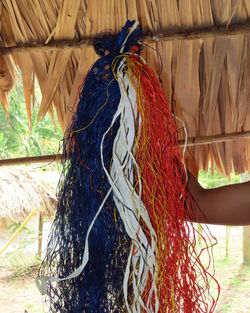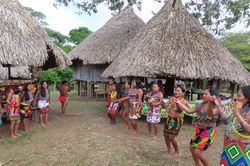top of page

Panama's Untamed Wilderness: Exploring the Enchanting Darien Province
 The Harpy Eagle is the National Bird of Panama. This eagle is relatively rare and elusive throughout its range. The species is nearly extinct in Central America, likely due to the logging industry's decimation of much of the rainforests. Their habitat is expected to decline further due to climate change. They avoid humans whenever possible. Exquisite photo was taken by Carlos Bethancourt |  The Harpy Eagle is considered one of the most powerful and largest raptors golbally. The length of the rear talons is about 4 to 5 inches, just the same as a grizzly bear's claws. Those talons tive the Harpy enough power and grip to lift prey up to their own weight. They are monogamous with a lifespanof 35 to 45 years and a bonded pair may stay together for 25 to so years. They stay in one place and establish their territory. Females are larger than males. Photo be Carlos Bethancourt |  Photo by Carlos Bethancourt |
|---|---|---|
 Photo by Carlos Bethancourt |
 Turmeric is used as one of the natural dye sources for the fibers making up the baskets and masks. |  The Splendid King Vulture decked out in beautiful colors |  Artesanal beauty | Handmade baskets made by the Wounaan people are full of beautiful naturally dyed pigments Embera Wounaan women make colourful baskets from fibres and chunga palm or nahuala plant called "hosigdi". These are materials that can be easily found in the rainforest. The baskets are dyed |
|---|---|---|
 This crocodile was spotted on the edge of the Chucunaque River in Yavisa. The town of Yavisa is where the Panamerican Highway ends. It starts in Alaska and ends in Yavisa. It cannot not be completed due to the dense and dangerous jungle conditions in Darien. |  Beautiful handmade baskets | These baskets of different sizes and shapes are all handcrafted works of art. Truly one of kind. No two are alike. |  Beautiful handmade baskets | These baskets of different sizes and shapes are all handcrafted works of art. Truly one of kind. No two are alike. |
 Campo Laurel | Campo Laurel is named after the laurel tree which this hut is built areounf. It offers protection from the sun and a place for the women to sell their wares. |  Canyon ball fruit | The fruit of the tree looks just like a hard ball |  White-faced capuchin scurrying through the jungle underbrush. |
 The ceiba tree wears an armor or huge thorns. Now that’s a protective coat of armor that nature has provided |  Chief Chamapuro is the man in charge of this Wounaan community of eighteen families at Campo Laurel His skin is decorated with a natural tattoo made with the juice of the jagua from the genip tree. The black pigment used to paint their skin lasts around 10 days. It is still used for all celebrations and is very important. |  Women wear ornamental necklaces made of coins which are passed down from mother to daughter. |
 Cocobolo is a tropical hardwood native to the area. It is very important to the Embery Wounaan people and the carvings the make from it are very delicate. Normally they depict birds, animals and canes. All the work is done manually by people dedicated solely to this art. Children can start at around age 7 through adulthood. Many of these carvings are passed from generation to generation. |  Cocobolo is a tropical hardwood native to the area. It is very important to the Embery Wounaan people and the carvings the make from it are very delicate. Normally they depict birds, animals and canes. All the work is done manually by people dedicated solely to this art. Children can start at around age 7 through adulthood. Many of these carvings are passed from generation to generation. |  The common relaxation area at Canopy Camp is covered from the sun and offers seating and hammocks for relaxation. |
 The Cuipo tree is enormous with a distinctive trunk |  Overview of the Darien area |  Delicate hand beaded jewelry |
 Also known as Monkey ladder. It truly looks like a ladder for the monkeys to climb up into the tall trees on. |  The deck of are tented area looks directly into the jungle. You are surrounded by all the sites and sounds of nature at your doorstep. |  As we sat on our deck and looked up we saw this green iguana hanging out in the treetops. Happy to have him up there eating insects for us. |
 Moises Chamapuro, the chief's son holding a cocobolo carving |  These are some of the fibers used to weave baskets and masks. The have been dried and dyed naturally. |  When we visited an Embera camp they were cooking lunch. The fried tilapia and made patacones which were served up in banana leaves. |
 Panama Tree trunk |  Bathrooms were located in a separate room to the right of our tent. Not much better than an outdoor shower while listening to the wildlife. |  The Wounaan still grind their sugar cane by hand. It is a two person job. We gave it a shot but they were much more efficient at the process. |
 The tagua nut has a strong resemblance to animal ivory making it a wonderful source for making many beautiful things. Using it also protects the rain forest as a sustainable income for the people, The carvings are beautiful. |  The tagua nut takes approximately three months of drying in the sun before it is hardened and ready to be carved |  The Harpy Eagle is the national bird of Panama. This is a beautiful carved tagua nut depiction of the bird. |
 The Wounaan tribe of Campo Laurel. These people are incredibly welcoming and happy. |  What a joy to see this Yellow Throated Toucan. |
bottom of page